Business Environment Analysis Report: Unit 1, Semester 1, 2022
VerifiedAdded on 2022/12/12
|9
|2482
|437
Report
AI Summary
This report provides a detailed analysis of Tesco PLC's business environment, focusing on the positive and negative impacts of the macro environment. It utilizes PESTEL analysis to examine political, economic, social, technological, environmental, and legal factors affecting the company. The report also conducts a SWOT analysis to identify Tesco's internal strengths and weaknesses, as well as external opportunities and threats. Furthermore, it explores the interrelationship between these internal and external factors, demonstrating how they influence decision-making within the organization. The analysis considers the impact of various market trends, technological advancements, and competitive pressures on Tesco's performance and strategic planning. The report concludes with a summary of findings and recommendations for the company to navigate the complex business landscape.
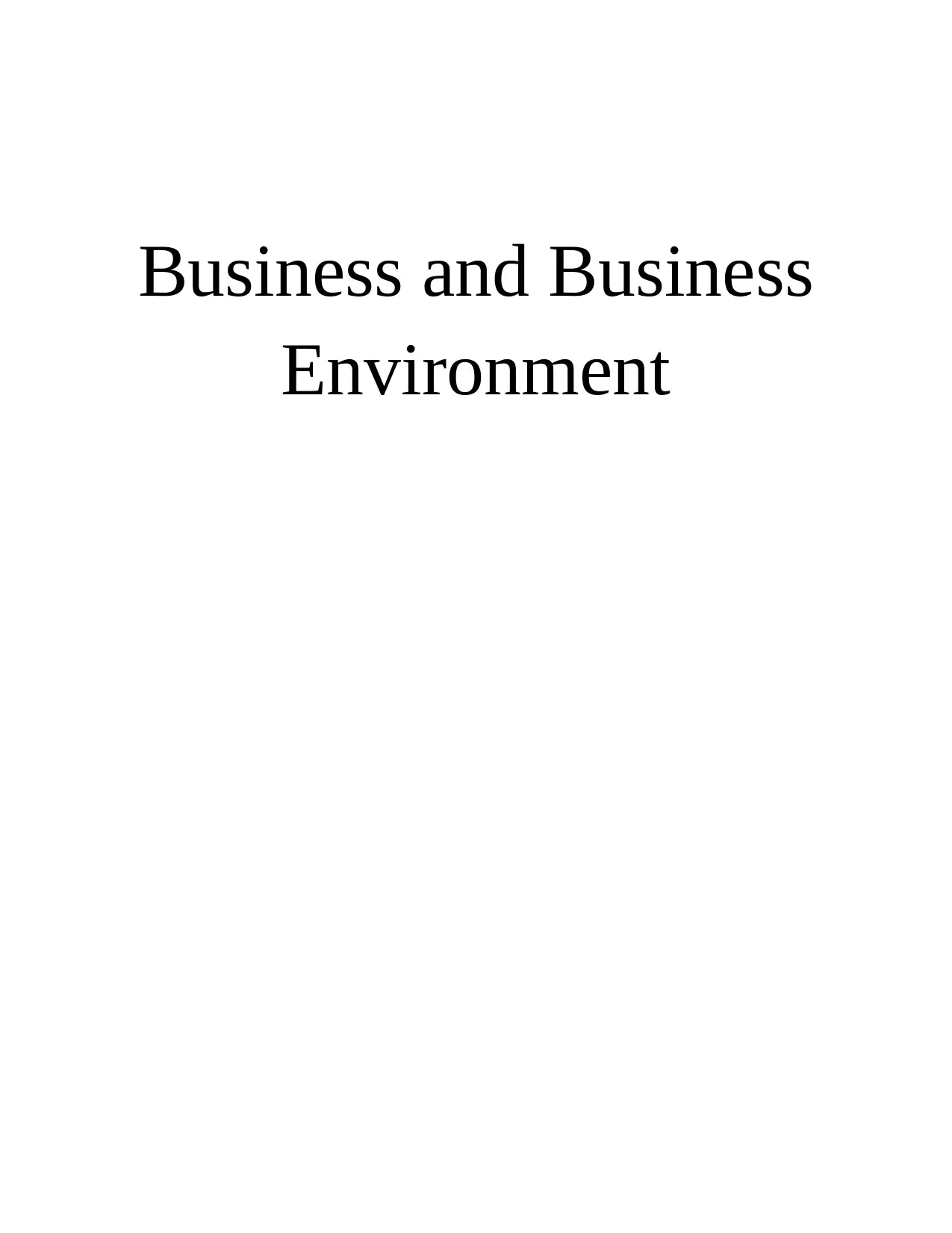
Business and Business
Environment
Environment
Paraphrase This Document
Need a fresh take? Get an instant paraphrase of this document with our AI Paraphraser
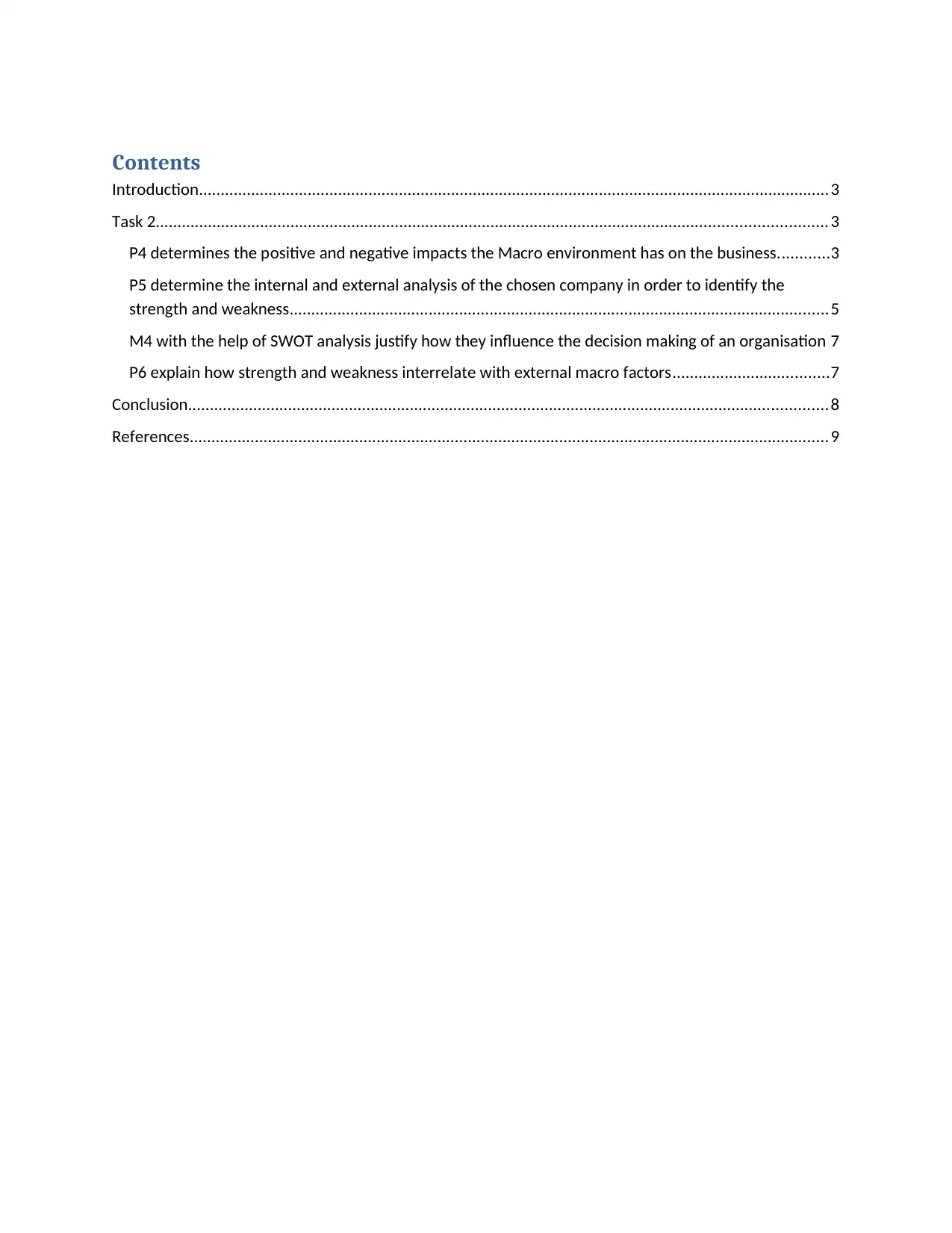
Contents
Introduction.................................................................................................................................................3
Task 2..........................................................................................................................................................3
P4 determines the positive and negative impacts the Macro environment has on the business............3
P5 determine the internal and external analysis of the chosen company in order to identify the
strength and weakness............................................................................................................................5
M4 with the help of SWOT analysis justify how they influence the decision making of an organisation 7
P6 explain how strength and weakness interrelate with external macro factors....................................7
Conclusion...................................................................................................................................................8
References...................................................................................................................................................9
Introduction.................................................................................................................................................3
Task 2..........................................................................................................................................................3
P4 determines the positive and negative impacts the Macro environment has on the business............3
P5 determine the internal and external analysis of the chosen company in order to identify the
strength and weakness............................................................................................................................5
M4 with the help of SWOT analysis justify how they influence the decision making of an organisation 7
P6 explain how strength and weakness interrelate with external macro factors....................................7
Conclusion...................................................................................................................................................8
References...................................................................................................................................................9
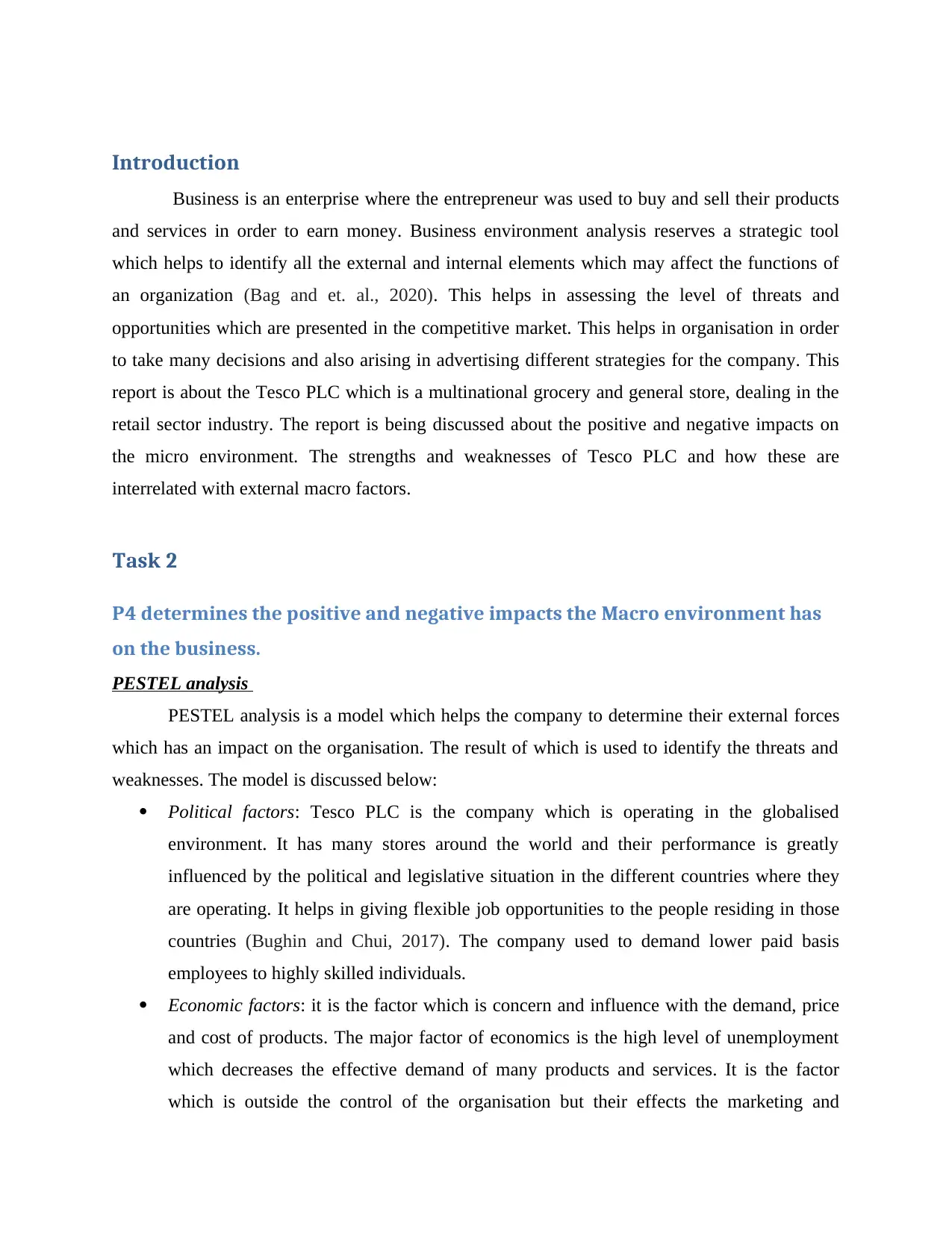
Introduction
Business is an enterprise where the entrepreneur was used to buy and sell their products
and services in order to earn money. Business environment analysis reserves a strategic tool
which helps to identify all the external and internal elements which may affect the functions of
an organization (Bag and et. al., 2020). This helps in assessing the level of threats and
opportunities which are presented in the competitive market. This helps in organisation in order
to take many decisions and also arising in advertising different strategies for the company. This
report is about the Tesco PLC which is a multinational grocery and general store, dealing in the
retail sector industry. The report is being discussed about the positive and negative impacts on
the micro environment. The strengths and weaknesses of Tesco PLC and how these are
interrelated with external macro factors.
Task 2
P4 determines the positive and negative impacts the Macro environment has
on the business.
PESTEL analysis
PESTEL analysis is a model which helps the company to determine their external forces
which has an impact on the organisation. The result of which is used to identify the threats and
weaknesses. The model is discussed below:
Political factors: Tesco PLC is the company which is operating in the globalised
environment. It has many stores around the world and their performance is greatly
influenced by the political and legislative situation in the different countries where they
are operating. It helps in giving flexible job opportunities to the people residing in those
countries (Bughin and Chui, 2017). The company used to demand lower paid basis
employees to highly skilled individuals.
Economic factors: it is the factor which is concern and influence with the demand, price
and cost of products. The major factor of economics is the high level of unemployment
which decreases the effective demand of many products and services. It is the factor
which is outside the control of the organisation but their effects the marketing and
Business is an enterprise where the entrepreneur was used to buy and sell their products
and services in order to earn money. Business environment analysis reserves a strategic tool
which helps to identify all the external and internal elements which may affect the functions of
an organization (Bag and et. al., 2020). This helps in assessing the level of threats and
opportunities which are presented in the competitive market. This helps in organisation in order
to take many decisions and also arising in advertising different strategies for the company. This
report is about the Tesco PLC which is a multinational grocery and general store, dealing in the
retail sector industry. The report is being discussed about the positive and negative impacts on
the micro environment. The strengths and weaknesses of Tesco PLC and how these are
interrelated with external macro factors.
Task 2
P4 determines the positive and negative impacts the Macro environment has
on the business.
PESTEL analysis
PESTEL analysis is a model which helps the company to determine their external forces
which has an impact on the organisation. The result of which is used to identify the threats and
weaknesses. The model is discussed below:
Political factors: Tesco PLC is the company which is operating in the globalised
environment. It has many stores around the world and their performance is greatly
influenced by the political and legislative situation in the different countries where they
are operating. It helps in giving flexible job opportunities to the people residing in those
countries (Bughin and Chui, 2017). The company used to demand lower paid basis
employees to highly skilled individuals.
Economic factors: it is the factor which is concern and influence with the demand, price
and cost of products. The major factor of economics is the high level of unemployment
which decreases the effective demand of many products and services. It is the factor
which is outside the control of the organisation but their effects the marketing and
⊘ This is a preview!⊘
Do you want full access?
Subscribe today to unlock all pages.

Trusted by 1+ million students worldwide
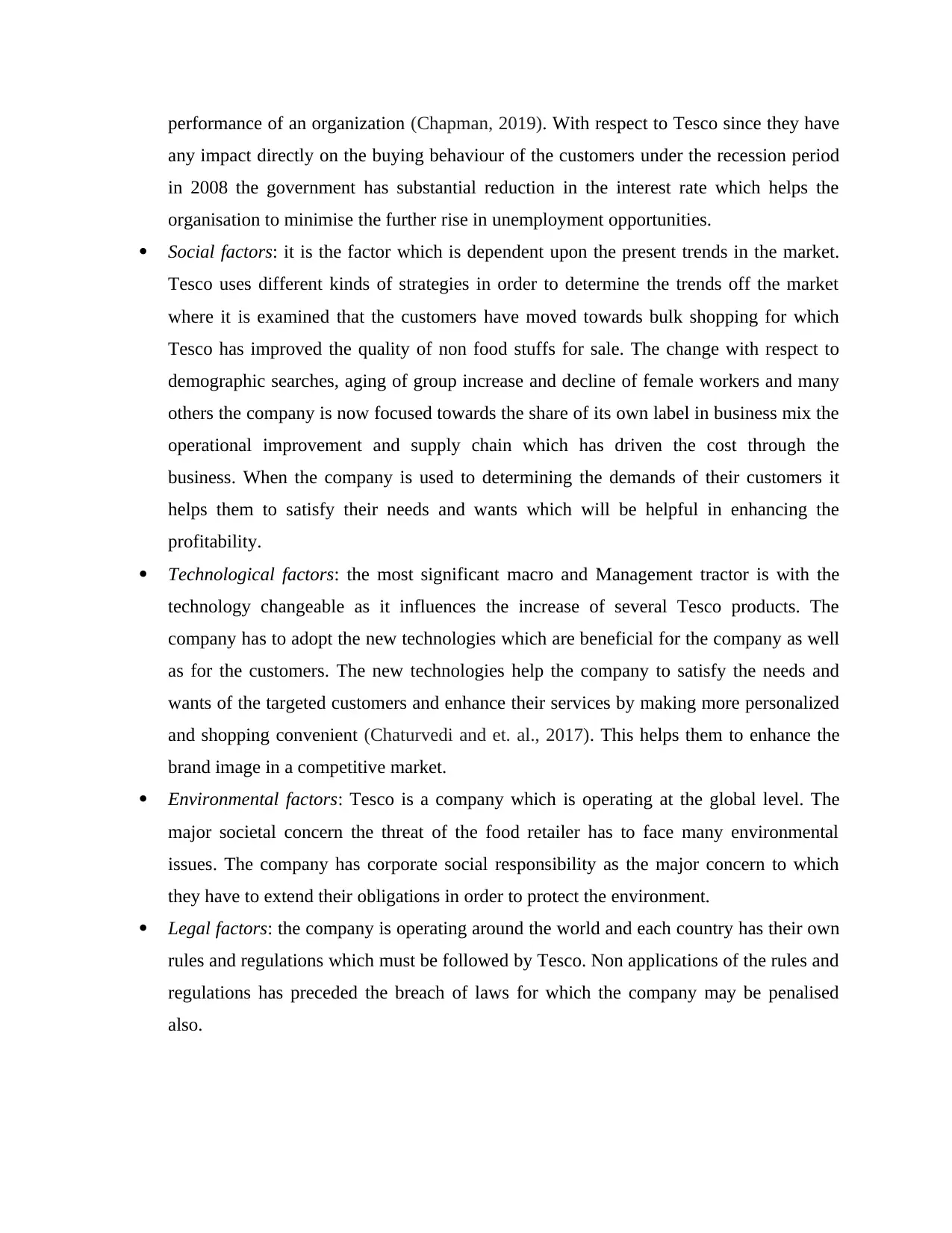
performance of an organization (Chapman, 2019). With respect to Tesco since they have
any impact directly on the buying behaviour of the customers under the recession period
in 2008 the government has substantial reduction in the interest rate which helps the
organisation to minimise the further rise in unemployment opportunities.
Social factors: it is the factor which is dependent upon the present trends in the market.
Tesco uses different kinds of strategies in order to determine the trends off the market
where it is examined that the customers have moved towards bulk shopping for which
Tesco has improved the quality of non food stuffs for sale. The change with respect to
demographic searches, aging of group increase and decline of female workers and many
others the company is now focused towards the share of its own label in business mix the
operational improvement and supply chain which has driven the cost through the
business. When the company is used to determining the demands of their customers it
helps them to satisfy their needs and wants which will be helpful in enhancing the
profitability.
Technological factors: the most significant macro and Management tractor is with the
technology changeable as it influences the increase of several Tesco products. The
company has to adopt the new technologies which are beneficial for the company as well
as for the customers. The new technologies help the company to satisfy the needs and
wants of the targeted customers and enhance their services by making more personalized
and shopping convenient (Chaturvedi and et. al., 2017). This helps them to enhance the
brand image in a competitive market.
Environmental factors: Tesco is a company which is operating at the global level. The
major societal concern the threat of the food retailer has to face many environmental
issues. The company has corporate social responsibility as the major concern to which
they have to extend their obligations in order to protect the environment.
Legal factors: the company is operating around the world and each country has their own
rules and regulations which must be followed by Tesco. Non applications of the rules and
regulations has preceded the breach of laws for which the company may be penalised
also.
any impact directly on the buying behaviour of the customers under the recession period
in 2008 the government has substantial reduction in the interest rate which helps the
organisation to minimise the further rise in unemployment opportunities.
Social factors: it is the factor which is dependent upon the present trends in the market.
Tesco uses different kinds of strategies in order to determine the trends off the market
where it is examined that the customers have moved towards bulk shopping for which
Tesco has improved the quality of non food stuffs for sale. The change with respect to
demographic searches, aging of group increase and decline of female workers and many
others the company is now focused towards the share of its own label in business mix the
operational improvement and supply chain which has driven the cost through the
business. When the company is used to determining the demands of their customers it
helps them to satisfy their needs and wants which will be helpful in enhancing the
profitability.
Technological factors: the most significant macro and Management tractor is with the
technology changeable as it influences the increase of several Tesco products. The
company has to adopt the new technologies which are beneficial for the company as well
as for the customers. The new technologies help the company to satisfy the needs and
wants of the targeted customers and enhance their services by making more personalized
and shopping convenient (Chaturvedi and et. al., 2017). This helps them to enhance the
brand image in a competitive market.
Environmental factors: Tesco is a company which is operating at the global level. The
major societal concern the threat of the food retailer has to face many environmental
issues. The company has corporate social responsibility as the major concern to which
they have to extend their obligations in order to protect the environment.
Legal factors: the company is operating around the world and each country has their own
rules and regulations which must be followed by Tesco. Non applications of the rules and
regulations has preceded the breach of laws for which the company may be penalised
also.
Paraphrase This Document
Need a fresh take? Get an instant paraphrase of this document with our AI Paraphraser
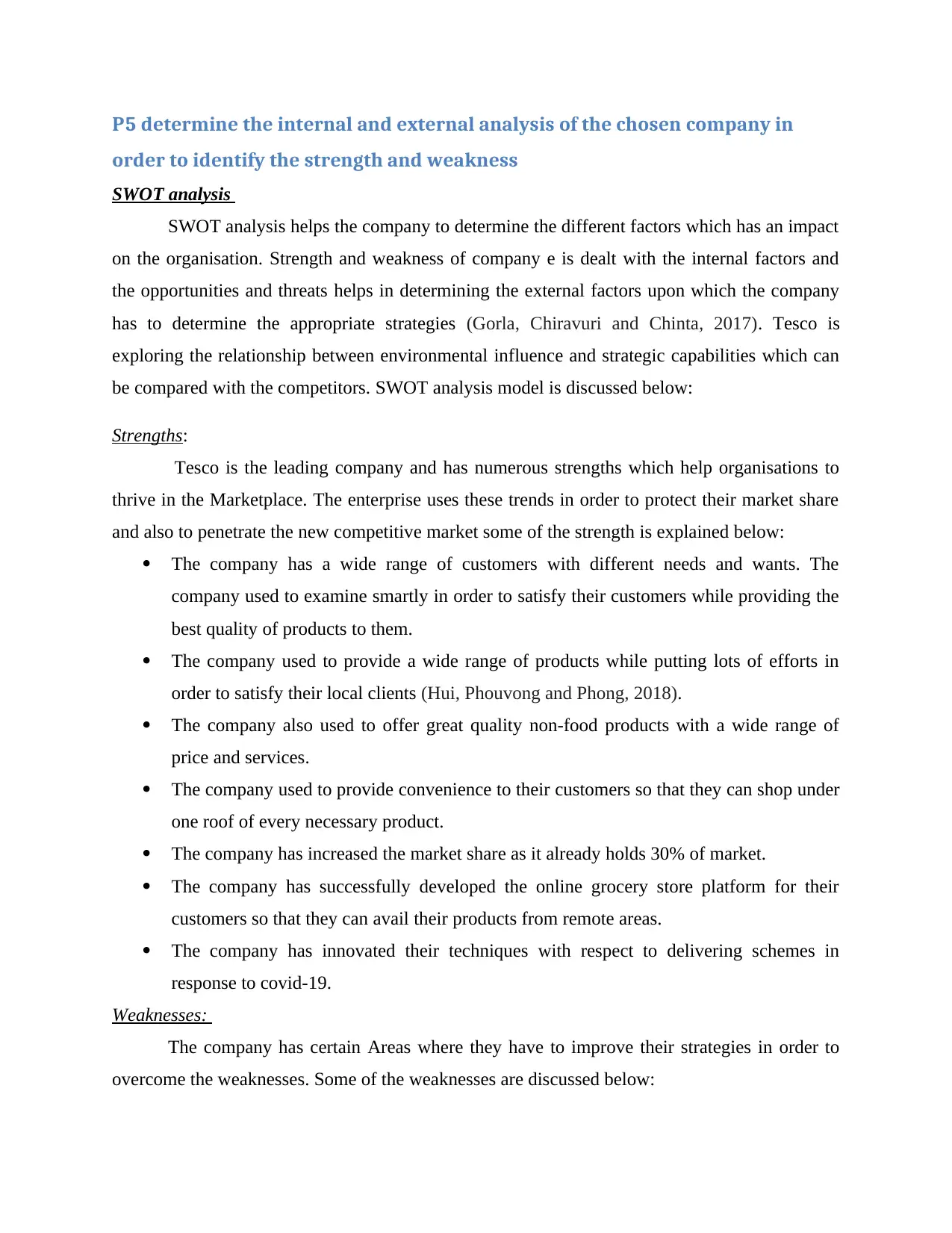
P5 determine the internal and external analysis of the chosen company in
order to identify the strength and weakness
SWOT analysis
SWOT analysis helps the company to determine the different factors which has an impact
on the organisation. Strength and weakness of company e is dealt with the internal factors and
the opportunities and threats helps in determining the external factors upon which the company
has to determine the appropriate strategies (Gorla, Chiravuri and Chinta, 2017). Tesco is
exploring the relationship between environmental influence and strategic capabilities which can
be compared with the competitors. SWOT analysis model is discussed below:
Strengths:
Tesco is the leading company and has numerous strengths which help organisations to
thrive in the Marketplace. The enterprise uses these trends in order to protect their market share
and also to penetrate the new competitive market some of the strength is explained below:
The company has a wide range of customers with different needs and wants. The
company used to examine smartly in order to satisfy their customers while providing the
best quality of products to them.
The company used to provide a wide range of products while putting lots of efforts in
order to satisfy their local clients (Hui, Phouvong and Phong, 2018).
The company also used to offer great quality non-food products with a wide range of
price and services.
The company used to provide convenience to their customers so that they can shop under
one roof of every necessary product.
The company has increased the market share as it already holds 30% of market.
The company has successfully developed the online grocery store platform for their
customers so that they can avail their products from remote areas.
The company has innovated their techniques with respect to delivering schemes in
response to covid-19.
Weaknesses:
The company has certain Areas where they have to improve their strategies in order to
overcome the weaknesses. Some of the weaknesses are discussed below:
order to identify the strength and weakness
SWOT analysis
SWOT analysis helps the company to determine the different factors which has an impact
on the organisation. Strength and weakness of company e is dealt with the internal factors and
the opportunities and threats helps in determining the external factors upon which the company
has to determine the appropriate strategies (Gorla, Chiravuri and Chinta, 2017). Tesco is
exploring the relationship between environmental influence and strategic capabilities which can
be compared with the competitors. SWOT analysis model is discussed below:
Strengths:
Tesco is the leading company and has numerous strengths which help organisations to
thrive in the Marketplace. The enterprise uses these trends in order to protect their market share
and also to penetrate the new competitive market some of the strength is explained below:
The company has a wide range of customers with different needs and wants. The
company used to examine smartly in order to satisfy their customers while providing the
best quality of products to them.
The company used to provide a wide range of products while putting lots of efforts in
order to satisfy their local clients (Hui, Phouvong and Phong, 2018).
The company also used to offer great quality non-food products with a wide range of
price and services.
The company used to provide convenience to their customers so that they can shop under
one roof of every necessary product.
The company has increased the market share as it already holds 30% of market.
The company has successfully developed the online grocery store platform for their
customers so that they can avail their products from remote areas.
The company has innovated their techniques with respect to delivering schemes in
response to covid-19.
Weaknesses:
The company has certain Areas where they have to improve their strategies in order to
overcome the weaknesses. Some of the weaknesses are discussed below:
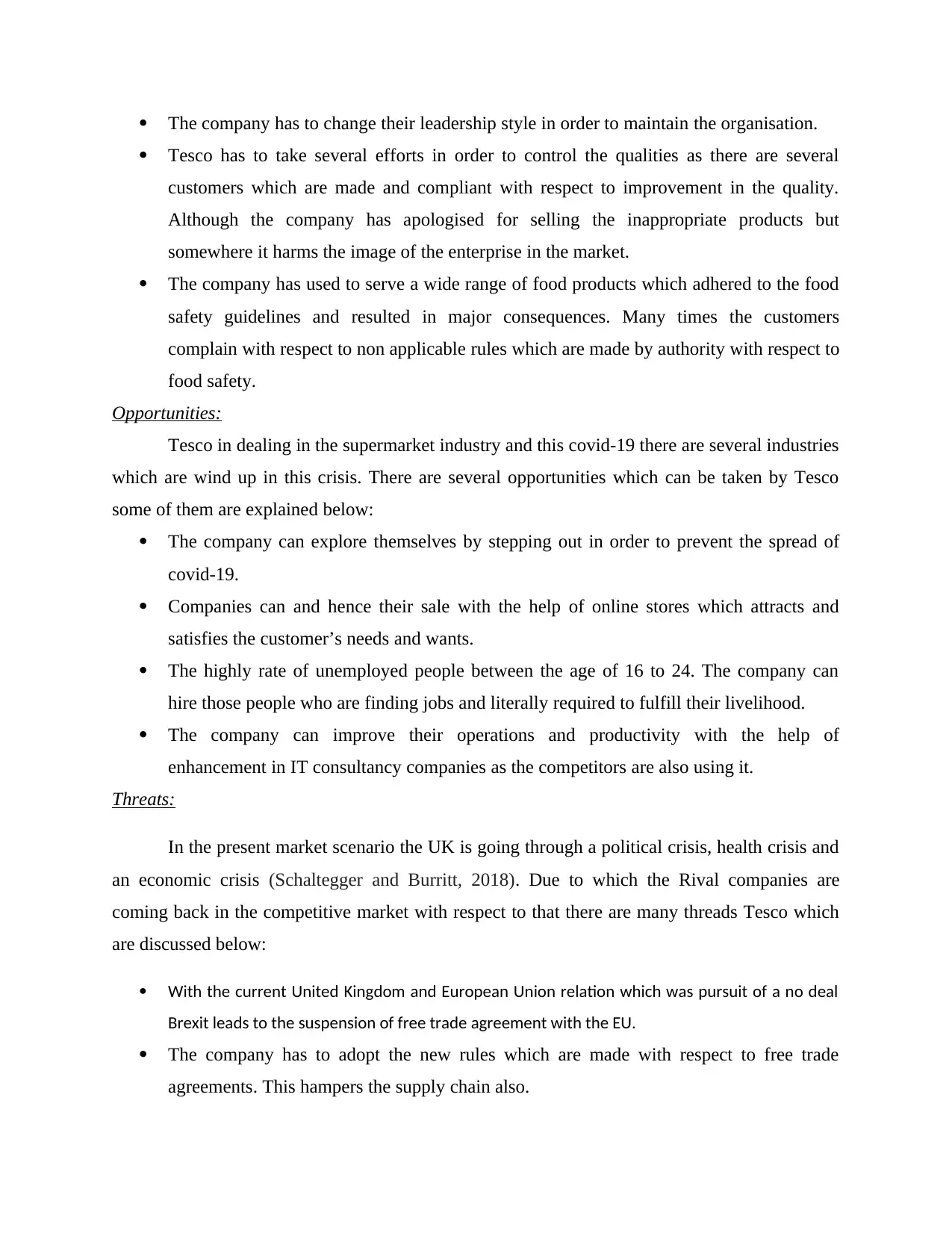
The company has to change their leadership style in order to maintain the organisation.
Tesco has to take several efforts in order to control the qualities as there are several
customers which are made and compliant with respect to improvement in the quality.
Although the company has apologised for selling the inappropriate products but
somewhere it harms the image of the enterprise in the market.
The company has used to serve a wide range of food products which adhered to the food
safety guidelines and resulted in major consequences. Many times the customers
complain with respect to non applicable rules which are made by authority with respect to
food safety.
Opportunities:
Tesco in dealing in the supermarket industry and this covid-19 there are several industries
which are wind up in this crisis. There are several opportunities which can be taken by Tesco
some of them are explained below:
The company can explore themselves by stepping out in order to prevent the spread of
covid-19.
Companies can and hence their sale with the help of online stores which attracts and
satisfies the customer’s needs and wants.
The highly rate of unemployed people between the age of 16 to 24. The company can
hire those people who are finding jobs and literally required to fulfill their livelihood.
The company can improve their operations and productivity with the help of
enhancement in IT consultancy companies as the competitors are also using it.
Threats:
In the present market scenario the UK is going through a political crisis, health crisis and
an economic crisis (Schaltegger and Burritt, 2018). Due to which the Rival companies are
coming back in the competitive market with respect to that there are many threads Tesco which
are discussed below:
With the current United Kingdom and European Union relation which was pursuit of a no deal
Brexit leads to the suspension of free trade agreement with the EU.
The company has to adopt the new rules which are made with respect to free trade
agreements. This hampers the supply chain also.
Tesco has to take several efforts in order to control the qualities as there are several
customers which are made and compliant with respect to improvement in the quality.
Although the company has apologised for selling the inappropriate products but
somewhere it harms the image of the enterprise in the market.
The company has used to serve a wide range of food products which adhered to the food
safety guidelines and resulted in major consequences. Many times the customers
complain with respect to non applicable rules which are made by authority with respect to
food safety.
Opportunities:
Tesco in dealing in the supermarket industry and this covid-19 there are several industries
which are wind up in this crisis. There are several opportunities which can be taken by Tesco
some of them are explained below:
The company can explore themselves by stepping out in order to prevent the spread of
covid-19.
Companies can and hence their sale with the help of online stores which attracts and
satisfies the customer’s needs and wants.
The highly rate of unemployed people between the age of 16 to 24. The company can
hire those people who are finding jobs and literally required to fulfill their livelihood.
The company can improve their operations and productivity with the help of
enhancement in IT consultancy companies as the competitors are also using it.
Threats:
In the present market scenario the UK is going through a political crisis, health crisis and
an economic crisis (Schaltegger and Burritt, 2018). Due to which the Rival companies are
coming back in the competitive market with respect to that there are many threads Tesco which
are discussed below:
With the current United Kingdom and European Union relation which was pursuit of a no deal
Brexit leads to the suspension of free trade agreement with the EU.
The company has to adopt the new rules which are made with respect to free trade
agreements. This hampers the supply chain also.
⊘ This is a preview!⊘
Do you want full access?
Subscribe today to unlock all pages.

Trusted by 1+ million students worldwide
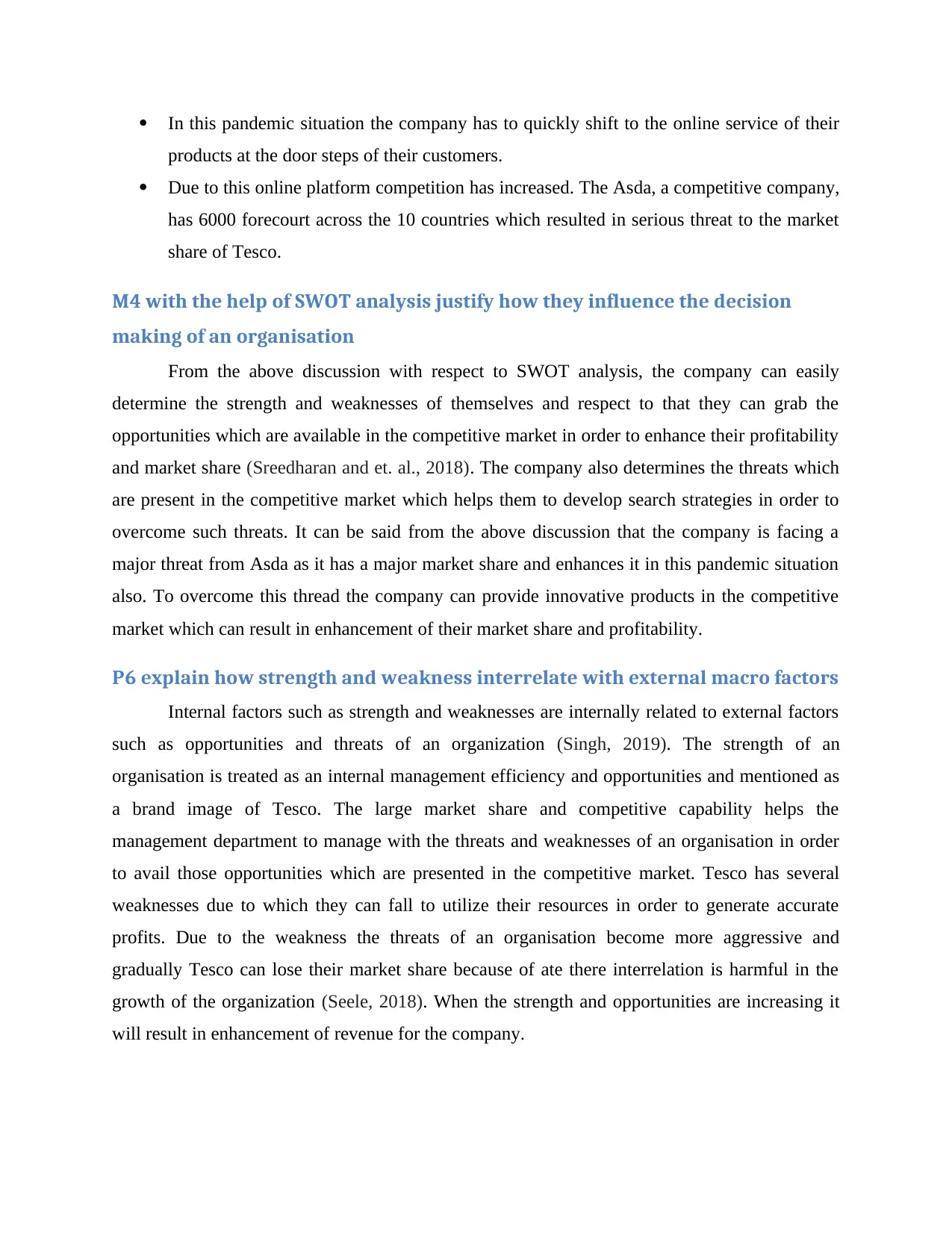
In this pandemic situation the company has to quickly shift to the online service of their
products at the door steps of their customers.
Due to this online platform competition has increased. The Asda, a competitive company,
has 6000 forecourt across the 10 countries which resulted in serious threat to the market
share of Tesco.
M4 with the help of SWOT analysis justify how they influence the decision
making of an organisation
From the above discussion with respect to SWOT analysis, the company can easily
determine the strength and weaknesses of themselves and respect to that they can grab the
opportunities which are available in the competitive market in order to enhance their profitability
and market share (Sreedharan and et. al., 2018). The company also determines the threats which
are present in the competitive market which helps them to develop search strategies in order to
overcome such threats. It can be said from the above discussion that the company is facing a
major threat from Asda as it has a major market share and enhances it in this pandemic situation
also. To overcome this thread the company can provide innovative products in the competitive
market which can result in enhancement of their market share and profitability.
P6 explain how strength and weakness interrelate with external macro factors
Internal factors such as strength and weaknesses are internally related to external factors
such as opportunities and threats of an organization (Singh, 2019). The strength of an
organisation is treated as an internal management efficiency and opportunities and mentioned as
a brand image of Tesco. The large market share and competitive capability helps the
management department to manage with the threats and weaknesses of an organisation in order
to avail those opportunities which are presented in the competitive market. Tesco has several
weaknesses due to which they can fall to utilize their resources in order to generate accurate
profits. Due to the weakness the threats of an organisation become more aggressive and
gradually Tesco can lose their market share because of ate there interrelation is harmful in the
growth of the organization (Seele, 2018). When the strength and opportunities are increasing it
will result in enhancement of revenue for the company.
products at the door steps of their customers.
Due to this online platform competition has increased. The Asda, a competitive company,
has 6000 forecourt across the 10 countries which resulted in serious threat to the market
share of Tesco.
M4 with the help of SWOT analysis justify how they influence the decision
making of an organisation
From the above discussion with respect to SWOT analysis, the company can easily
determine the strength and weaknesses of themselves and respect to that they can grab the
opportunities which are available in the competitive market in order to enhance their profitability
and market share (Sreedharan and et. al., 2018). The company also determines the threats which
are present in the competitive market which helps them to develop search strategies in order to
overcome such threats. It can be said from the above discussion that the company is facing a
major threat from Asda as it has a major market share and enhances it in this pandemic situation
also. To overcome this thread the company can provide innovative products in the competitive
market which can result in enhancement of their market share and profitability.
P6 explain how strength and weakness interrelate with external macro factors
Internal factors such as strength and weaknesses are internally related to external factors
such as opportunities and threats of an organization (Singh, 2019). The strength of an
organisation is treated as an internal management efficiency and opportunities and mentioned as
a brand image of Tesco. The large market share and competitive capability helps the
management department to manage with the threats and weaknesses of an organisation in order
to avail those opportunities which are presented in the competitive market. Tesco has several
weaknesses due to which they can fall to utilize their resources in order to generate accurate
profits. Due to the weakness the threats of an organisation become more aggressive and
gradually Tesco can lose their market share because of ate there interrelation is harmful in the
growth of the organization (Seele, 2018). When the strength and opportunities are increasing it
will result in enhancement of revenue for the company.
Paraphrase This Document
Need a fresh take? Get an instant paraphrase of this document with our AI Paraphraser
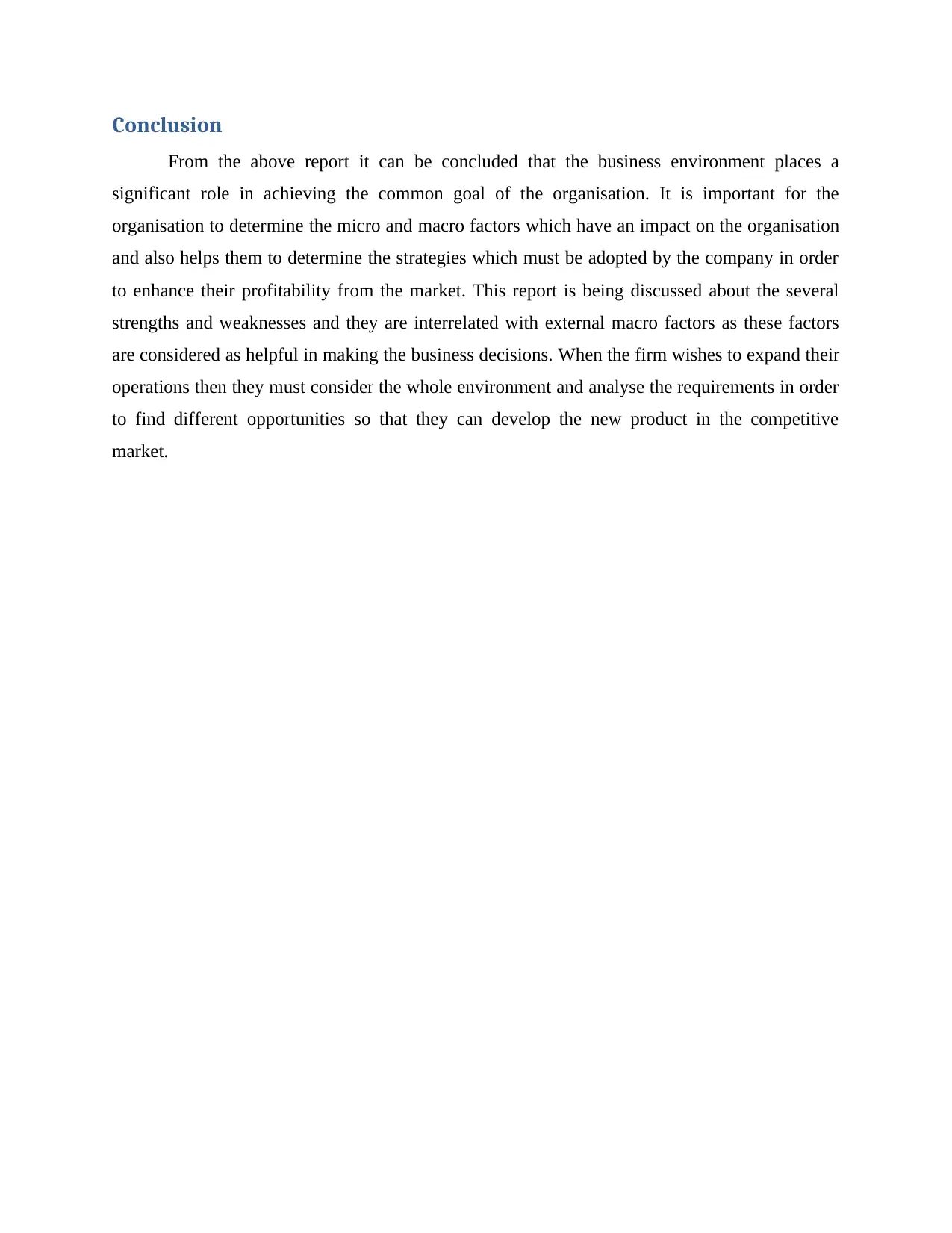
Conclusion
From the above report it can be concluded that the business environment places a
significant role in achieving the common goal of the organisation. It is important for the
organisation to determine the micro and macro factors which have an impact on the organisation
and also helps them to determine the strategies which must be adopted by the company in order
to enhance their profitability from the market. This report is being discussed about the several
strengths and weaknesses and they are interrelated with external macro factors as these factors
are considered as helpful in making the business decisions. When the firm wishes to expand their
operations then they must consider the whole environment and analyse the requirements in order
to find different opportunities so that they can develop the new product in the competitive
market.
From the above report it can be concluded that the business environment places a
significant role in achieving the common goal of the organisation. It is important for the
organisation to determine the micro and macro factors which have an impact on the organisation
and also helps them to determine the strategies which must be adopted by the company in order
to enhance their profitability from the market. This report is being discussed about the several
strengths and weaknesses and they are interrelated with external macro factors as these factors
are considered as helpful in making the business decisions. When the firm wishes to expand their
operations then they must consider the whole environment and analyse the requirements in order
to find different opportunities so that they can develop the new product in the competitive
market.
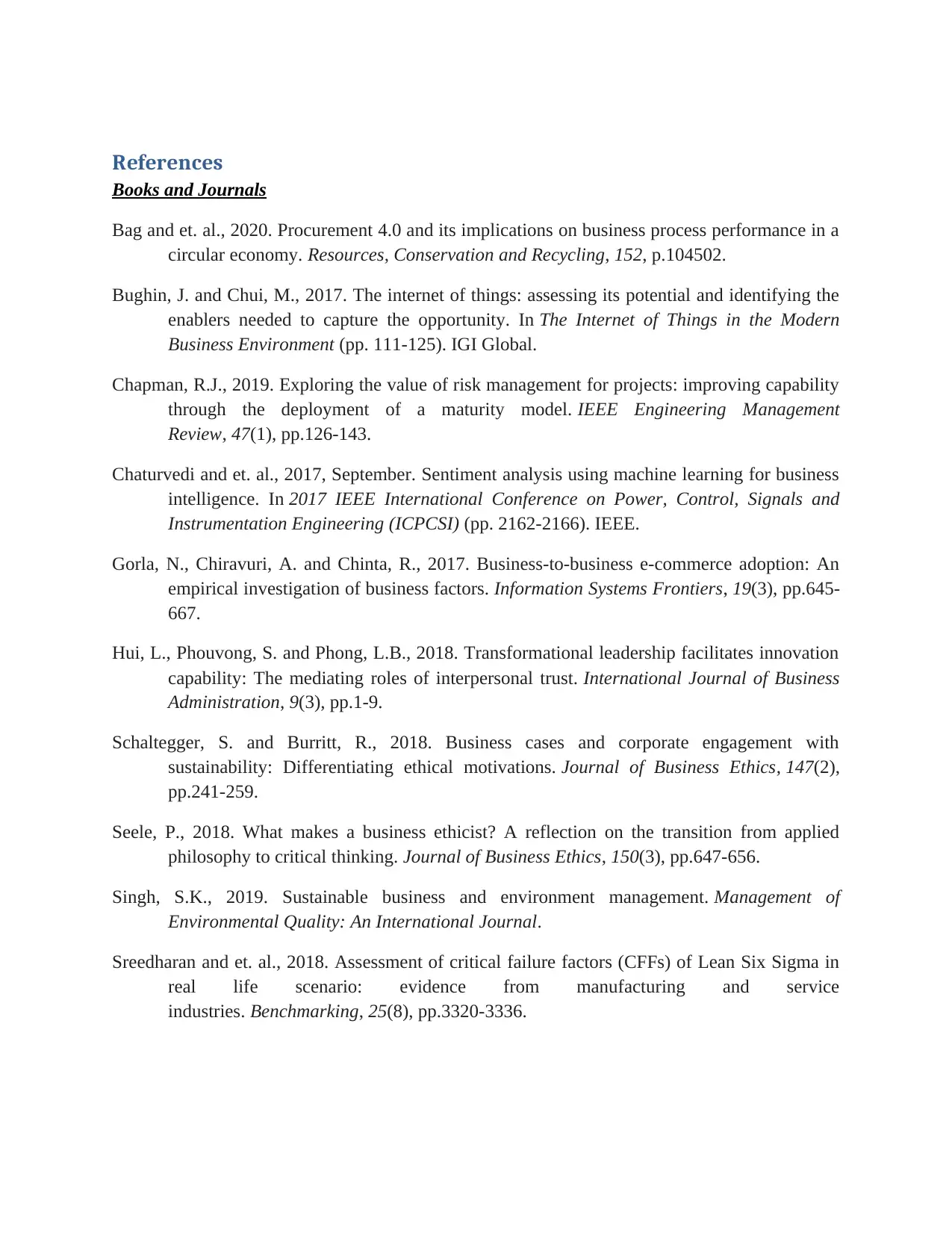
References
Books and Journals
Bag and et. al., 2020. Procurement 4.0 and its implications on business process performance in a
circular economy. Resources, Conservation and Recycling, 152, p.104502.
Bughin, J. and Chui, M., 2017. The internet of things: assessing its potential and identifying the
enablers needed to capture the opportunity. In The Internet of Things in the Modern
Business Environment (pp. 111-125). IGI Global.
Chapman, R.J., 2019. Exploring the value of risk management for projects: improving capability
through the deployment of a maturity model. IEEE Engineering Management
Review, 47(1), pp.126-143.
Chaturvedi and et. al., 2017, September. Sentiment analysis using machine learning for business
intelligence. In 2017 IEEE International Conference on Power, Control, Signals and
Instrumentation Engineering (ICPCSI) (pp. 2162-2166). IEEE.
Gorla, N., Chiravuri, A. and Chinta, R., 2017. Business-to-business e-commerce adoption: An
empirical investigation of business factors. Information Systems Frontiers, 19(3), pp.645-
667.
Hui, L., Phouvong, S. and Phong, L.B., 2018. Transformational leadership facilitates innovation
capability: The mediating roles of interpersonal trust. International Journal of Business
Administration, 9(3), pp.1-9.
Schaltegger, S. and Burritt, R., 2018. Business cases and corporate engagement with
sustainability: Differentiating ethical motivations. Journal of Business Ethics, 147(2),
pp.241-259.
Seele, P., 2018. What makes a business ethicist? A reflection on the transition from applied
philosophy to critical thinking. Journal of Business Ethics, 150(3), pp.647-656.
Singh, S.K., 2019. Sustainable business and environment management. Management of
Environmental Quality: An International Journal.
Sreedharan and et. al., 2018. Assessment of critical failure factors (CFFs) of Lean Six Sigma in
real life scenario: evidence from manufacturing and service
industries. Benchmarking, 25(8), pp.3320-3336.
Books and Journals
Bag and et. al., 2020. Procurement 4.0 and its implications on business process performance in a
circular economy. Resources, Conservation and Recycling, 152, p.104502.
Bughin, J. and Chui, M., 2017. The internet of things: assessing its potential and identifying the
enablers needed to capture the opportunity. In The Internet of Things in the Modern
Business Environment (pp. 111-125). IGI Global.
Chapman, R.J., 2019. Exploring the value of risk management for projects: improving capability
through the deployment of a maturity model. IEEE Engineering Management
Review, 47(1), pp.126-143.
Chaturvedi and et. al., 2017, September. Sentiment analysis using machine learning for business
intelligence. In 2017 IEEE International Conference on Power, Control, Signals and
Instrumentation Engineering (ICPCSI) (pp. 2162-2166). IEEE.
Gorla, N., Chiravuri, A. and Chinta, R., 2017. Business-to-business e-commerce adoption: An
empirical investigation of business factors. Information Systems Frontiers, 19(3), pp.645-
667.
Hui, L., Phouvong, S. and Phong, L.B., 2018. Transformational leadership facilitates innovation
capability: The mediating roles of interpersonal trust. International Journal of Business
Administration, 9(3), pp.1-9.
Schaltegger, S. and Burritt, R., 2018. Business cases and corporate engagement with
sustainability: Differentiating ethical motivations. Journal of Business Ethics, 147(2),
pp.241-259.
Seele, P., 2018. What makes a business ethicist? A reflection on the transition from applied
philosophy to critical thinking. Journal of Business Ethics, 150(3), pp.647-656.
Singh, S.K., 2019. Sustainable business and environment management. Management of
Environmental Quality: An International Journal.
Sreedharan and et. al., 2018. Assessment of critical failure factors (CFFs) of Lean Six Sigma in
real life scenario: evidence from manufacturing and service
industries. Benchmarking, 25(8), pp.3320-3336.
⊘ This is a preview!⊘
Do you want full access?
Subscribe today to unlock all pages.

Trusted by 1+ million students worldwide
1 out of 9
Related Documents
Your All-in-One AI-Powered Toolkit for Academic Success.
+13062052269
info@desklib.com
Available 24*7 on WhatsApp / Email
![[object Object]](/_next/static/media/star-bottom.7253800d.svg)
Unlock your academic potential
Copyright © 2020–2025 A2Z Services. All Rights Reserved. Developed and managed by ZUCOL.




